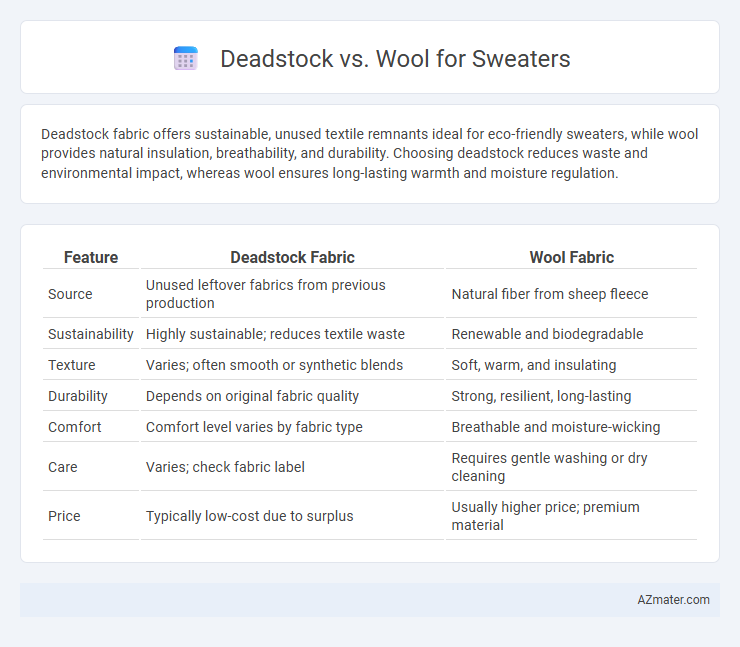Deadstock fabric offers sustainable, unused textile remnants ideal for eco-friendly sweaters, while wool provides natural insulation, breathability, and durability. Choosing deadstock reduces waste and environmental impact, whereas wool ensures long-lasting warmth and moisture regulation.
Table of Comparison
| Feature | Deadstock Fabric | Wool Fabric |
|---|---|---|
| Source | Unused leftover fabrics from previous production | Natural fiber from sheep fleece |
| Sustainability | Highly sustainable; reduces textile waste | Renewable and biodegradable |
| Texture | Varies; often smooth or synthetic blends | Soft, warm, and insulating |
| Durability | Depends on original fabric quality | Strong, resilient, long-lasting |
| Comfort | Comfort level varies by fabric type | Breathable and moisture-wicking |
| Care | Varies; check fabric label | Requires gentle washing or dry cleaning |
| Price | Typically low-cost due to surplus | Usually higher price; premium material |
Introduction: Understanding Deadstock and Wool Sweaters
Deadstock sweaters are crafted from unused, surplus fabric, often vintage or limited edition, offering unique texture and style with an eco-friendly appeal. Wool sweaters are made from the natural fiber of sheep, known for exceptional warmth, durability, and breathability, making them a top choice for cold-weather apparel. Comparing deadstock versus wool involves weighing sustainability and distinctive aesthetics against natural insulation and traditional quality.
What Is Deadstock Material?
Deadstock material refers to unused, leftover fabric or garments from past production runs that remain unsold or unclaimed, often characterized by rare patterns or exclusive designs. In contrast to wool, which is a natural fiber sourced from sheep, deadstock fabric can be composed of various materials, offering sustainability benefits by reducing textile waste. Utilizing deadstock for sweaters supports eco-friendly fashion practices by recycling existing resources rather than relying on new raw materials like wool.
Benefits of Using Deadstock for Sweaters
Deadstock fabric offers a sustainable and eco-friendly alternative for sweater production by repurposing unused, surplus textiles that would otherwise contribute to waste. Utilizing deadstock reduces the environmental impact by minimizing the need for new raw materials, preserves unique patterns and textures not found in mass production, and supports circular fashion initiatives. This approach promotes a distinct aesthetic quality and exclusivity, making each sweater a one-of-a-kind garment while conserving resources and lowering carbon emissions.
What Makes Wool a Classic Sweater Choice?
Wool remains a classic sweater choice due to its natural insulating properties, breathability, and durability, which provide warmth without overheating. Its ability to wick moisture and resist wrinkles enhances comfort and longevity, making it suitable for various climates and activities. Unlike deadstock fabrics that prioritize sustainability through repurposing, wool's timeless performance and cozy texture maintain its enduring appeal in cold-weather apparel.
Comparing Sustainability: Deadstock vs Wool
Deadstock fabric uses surplus materials that would otherwise go to waste, significantly reducing resource consumption and textile waste compared to traditional wool production, which involves land use, water consumption, and methane emissions from sheep farming. Wool is biodegradable and renewable but has a higher environmental footprint due to the farming practices and processing chemicals involved. Choosing deadstock sweaters supports circular fashion by repurposing existing materials, whereas wool sweaters contribute to sustainability through natural fibers but require careful management of animal welfare and environmental impacts.
Comfort and Wearability: Deadstock and Wool
Deadstock sweaters often feature unique vintage fabrics that provide a distinct, worn-in comfort unmatched by new materials, while wool sweaters offer natural insulation and breathability ideal for temperature regulation. Wool's moisture-wicking properties enhance wearability by keeping the skin dry, whereas deadstock fabrics may vary in fiber content, influencing softness and durability. Both materials excel in comfort, but wool is typically preferred for long-term wear due to its resilience and adaptability to changing climates.
Style and Aesthetic Differences
Deadstock sweaters often feature unique, vintage-inspired patterns and textures unavailable in modern wool, giving them a distinctive, retro aesthetic that appeals to collectors and fashion enthusiasts. Wool sweaters provide a timeless, classic look with natural fibers that offer warmth, softness, and a clean finish, suitable for versatile styling across various settings. The contrast lies in deadstock's nostalgic charm and rarity versus wool's consistent quality and traditional elegance in sweater design.
Care and Longevity Considerations
Deadstock sweaters often feature vintage fabrics that require delicate handling, with cold water washing and air drying essential to maintain their integrity and prevent fabric deterioration. Wool sweaters benefit from regular gentle brushing to remove surface dirt and periodic airing to reduce odors, preserving fiber resilience and shape over time. Proper storage in cool, dry conditions and using moth repellents extends the longevity of both deadstock and wool garments, ensuring sustained wearability and aesthetic appeal.
Price and Accessibility Factors
Deadstock sweaters typically offer lower prices due to surplus or unsold inventory, making them accessible for budget-conscious shoppers seeking unique vintage styles. Wool sweaters, often crafted from high-quality, natural fibers, tend to be more expensive but provide superior warmth and durability, attracting consumers willing to invest in long-lasting garments. Accessibility varies as deadstock items may be limited and sporadically available, while wool sweaters are widely sold in retail stores and online, ensuring consistent availability.
Which Sweater Material is Right for You?
Deadstock fabric offers unique, limited-edition sweaters with vintage charm and sustainable appeal, ideal for fashion enthusiasts seeking distinct styles and eco-conscious options. Wool sweaters provide natural insulation, durability, and moisture-wicking properties, making them perfect for warmth and comfort in colder climates. Choosing between deadstock and wool depends on your preference for sustainability versus performance and long-lasting wear.

Infographic: Deadstock vs Wool for Sweater
 azmater.com
azmater.com